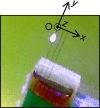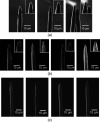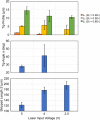Laser Sharpening of Carbon Fiber Microelectrode Arrays for Brain Recording
- PMID: 35833189
- PMCID: PMC8597551
- DOI: 10.1115/1.4049780
Laser Sharpening of Carbon Fiber Microelectrode Arrays for Brain Recording
Abstract
Microwire microelectrode arrays (MEAs) are implanted in the brain for recording neuron activities to study the brain function. Among various microwire materials, carbon fiber stands out due to its small diameter (5-10 μm), relatively high Young's modulus, and low electrical resistance. Microwire tips in MEAs are often sharpened to reduce the insertion force and prevent the thin microwires from buckling. Currently, carbon fiber MEAs are sharpened by either torch burning, which limits the positions of wire tips to a water bath surface plane, or electrical discharge machining, which is difficult to implement to the nonelectrically conductive carbon fiber with parylene-C insulation. A laser-based carbon fiber sharpening method proposed in this study enables the fabrication of carbon fiber MEAs with sharp tips and custom lengths. Experiments were conducted to study effects of laser input voltage and transverse speed on carbon fiber tip geometry. Results of the tip sharpness and stripped length of the insulation as well as the electrochemical impedance spectroscopy measurement at 1 kHz were evaluated and analyzed. The laser input voltage and traverse speed have demonstrated to be critical for the sharp tip, short stripped length, and low electrical impedance of the carbon fiber electrode for brain recording MEAs. A carbon fiber MEA with custom electrode lengths was fabricated to validate the laser-based approach.
Copyright © 2020 by ASME.
Figures
![Three sample carbon fiber MEAs (a) a bundle of 16 carbon fiber electrodes [13], (b) 2 × 8 carbon fiber array [11], and (c) 32 channel carbon fiber array assembled by Massey et al.](https://cdn.ncbi.nlm.nih.gov/pmc/blobs/71e1/8597551/0d41e4eceb03/jmnm-20-1041_041013_g001.gif)
![Sharp tip of metal microwire: (a) stainless steel microwire by chemical etching [31] and (b) tungsten microwire by ECM with KOH solution](https://cdn.ncbi.nlm.nih.gov/pmc/blobs/71e1/8597551/d616a9913f4e/jmnm-20-1041_041013_g002.gif)
![Carbon fiber sharpening methods and outcomes: (a) setup, (b) outcome of the torch burning method [13], (c) schematic diagram, and (d) outcome of EDM sharpening of carbon fiber [33]](https://cdn.ncbi.nlm.nih.gov/pmc/blobs/71e1/8597551/b0a17a84e42b/jmnm-20-1041_041013_g003.gif)








Similar articles
-
Open-source Toolkit: Benchtop Carbon Fiber Microelectrode Array for Nerve Recording.J Vis Exp. 2021 Oct 29;(176):10.3791/63099. doi: 10.3791/63099. J Vis Exp. 2021. PMID: 34779441 Free PMC article.
-
Plateau-Shaped Flexible Polymer Microelectrode Array for Neural Recording.Polymers (Basel). 2017 Dec 8;9(12):690. doi: 10.3390/polym9120690. Polymers (Basel). 2017. PMID: 30965988 Free PMC article.
-
3D Printed Skull Cap and Benchtop Fabricated Microwire-Based Microelectrode Array for Custom Rat Brain Recordings.Bioengineering (Basel). 2022 Oct 14;9(10):550. doi: 10.3390/bioengineering9100550. Bioengineering (Basel). 2022. PMID: 36290518 Free PMC article.
-
Fabrication of Planar Microelectrode Array Using Laser-Patterned ITO and SU-8.Micromachines (Basel). 2021 Oct 31;12(11):1347. doi: 10.3390/mi12111347. Micromachines (Basel). 2021. PMID: 34832760 Free PMC article.
-
Nanostructuration strategies to enhance microelectrode array (MEA) performance for neuronal recording and stimulation.J Physiol Paris. 2012 May-Aug;106(3-4):137-45. doi: 10.1016/j.jphysparis.2011.10.001. Epub 2011 Oct 18. J Physiol Paris. 2012. PMID: 22027264 Review.
Cited by
-
Design, Fabrication, and Implantation of Invasive Microelectrode Arrays as in vivo Brain Machine Interfaces: A Comprehensive Review.J Manuf Process. 2024 Sep 30;126:185-207. doi: 10.1016/j.jmapro.2024.07.100. Epub 2024 Jul 31. J Manuf Process. 2024. PMID: 39185373
-
Manufacturing Processes of Implantable Microelectrode Array for In Vivo Neural Electrophysiological Recordings and Stimulation: A State-Of-the-Art Review.J Micro Nanomanuf. 2022 Dec 1;10(4):041001. doi: 10.1115/1.4063179. Epub 2023 Oct 9. J Micro Nanomanuf. 2022. PMID: 37860671 Free PMC article.
-
Open-source Toolkit: Benchtop Carbon Fiber Microelectrode Array for Nerve Recording.J Vis Exp. 2021 Oct 29;(176):10.3791/63099. doi: 10.3791/63099. J Vis Exp. 2021. PMID: 34779441 Free PMC article.
-
Electrochemical HPLC Determination of Piperazine Antihistamine Drugs Employing a Spark-Generated Nickel Oxide Nanoparticle-Modified Carbon Fiber Microelectrode.ACS Omega. 2024 Jan 20;9(4):5038-5045. doi: 10.1021/acsomega.3c09474. eCollection 2024 Jan 30. ACS Omega. 2024. PMID: 38313503 Free PMC article.
References
-
- Drachman, D. A. , 2005, “ Do We Have Brain to Spare?,” Neurology, 64(12), pp. 2004–2005.10.1212/01.WNL.0000166914.38327.BB - DOI - PubMed
-
- Dale, A. M. , Liu, A. K. , Fischl, B. R. , Buckner, R. L. , Belliveau, J. W. , Lewine, J. D. , and Halgren, E. , 2000, “ Dynamic Statistical Parametric Mapping: Combining FMRI and MEG for High-Resolution Imaging of Cortical Activity,” Neuron, 26(1), pp. 55–67.10.1016/S0896-6273(00)81138-1 - DOI - PubMed
Grants and funding
LinkOut - more resources
Full Text Sources
